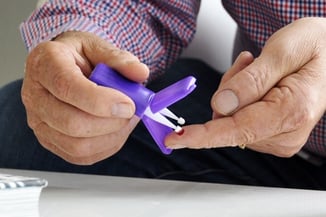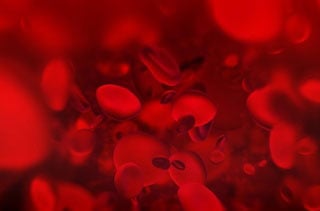Share this
choosing the best method for specimen collection
by Neoteryx Microsampling on Nov 1, 2021 9:00:00 AM
 The COVID-19 pandemic created a change in the way researchers collect specimen samples for scientific studies and clinical trials. During the pandemic, the scientific community found it difficult to recruit enough volunteers for studies and trials.
The COVID-19 pandemic created a change in the way researchers collect specimen samples for scientific studies and clinical trials. During the pandemic, the scientific community found it difficult to recruit enough volunteers for studies and trials.
Many research participants wanted to avoid exposure to the SARS-CoV-2 virus and the emerging variants that cause COVID-19 illness. Researchers found it necessary to pivot to a remote research model that allowed for remote sample collection and monitoring study participants from a distance.Study managers experimented with different approaches to remote research studies, including pop-up sampling stations in outdoor environments or drive-thru specimen collection.
/2022%20Mitra%20Lifestyle%20Images%20(approved)/mailing-no-cold-chain.jpeg?width=353&height=206&name=mailing-no-cold-chain.jpeg) Others mailed out Sample Collection Kits to study volunteers at home, enabling them to self-collect blood samples at home using a quick finger-stick.
Others mailed out Sample Collection Kits to study volunteers at home, enabling them to self-collect blood samples at home using a quick finger-stick.
With finger-stick microsampling, study volunteers were able to mail samples to the lab.
More researchers leveraged technologies that enabled remote specimen collection. This helped them comply with social distancing mandates and stay-at-home directives from governments and public health organizations. They learned that study volunteers are more likely to participate in remote research studies and virtual clinical trials that offer them remote or "mail-in" options.
Blood Collection Methods Used
For researchers accustomed to using conventional blood collection methods and liquid blood samples for their studies, the transition to remote technologies and dried blood spot (DBS) samples and lab workflows may require an adjustment. However, if they want their studies to move forward smoothly with the required number of study volunteers, they will need to adopt remote technologies.
 Blood samples are the starting point for a range of investigations.
Blood samples are the starting point for a range of investigations.
Blood samples are needed for serology studies that investigate the antibodies of SARS-CoV-2 and other infectious diseases, as well as the effects of the COVID-19 vaccines or the benefits of new drugs.
3 blood collection methods researchers typically use:
1. Arterial Sampling
Arterial sampling usually happens in a hospital environment, so may be used for onsite clinical trials. It entails collecting blood from an artery using a needle and syringe primarily to determine arterial blood gases (ABG). This procedure should only be performed by health professionals. Health professionals must demonstrate proficiency in arterial sampling after formal training.
Blood collected through this procedure is used to measure the levels of oxygen and carbon dioxide in the blood and determine the acid-base balance (pH).
2. Fingerstick Sampling
Also known as finger-stick blood collection, finger-stick sampling has become very popular because it allows for remote sampling at home, work or other environments. The technique entails low-volume sampling of just a few drops of blood.
.webp?width=303&height=216&name=hemaPEN-clinic-setting_(Not-approved).webp) The blood collection is performed by pricking the fingertip with a small lancet. When a blood drop forms on the fingertip, a microsampling tool like the Mitra® device or hemaPEN® is used to absorb the drop.
The blood collection is performed by pricking the fingertip with a small lancet. When a blood drop forms on the fingertip, a microsampling tool like the Mitra® device or hemaPEN® is used to absorb the drop.
The method is quick, nearly painless, and requires very little preparation.
It’s not always necessary for a healthcare professional to perform a finger-stick sampling procedure, as long as the end-user follows the illustrated instructions and/or watches a demonstration via an online video. Finger-stick sampling enables self-collection by virtually anyone.
The benefits for study volunteers include low-volume sampling and the ability to carry out specimen collection at home. Remote samples are typically analyzed as dried specimen microsamples, which volunteers can ship to the lab via standard mail because the samples don't require dry ice or refrigeration.
3. Venipuncture Sampling
Venipuncture is a common method used to collect blood samples from the median cubital vein in the arm of a study participant. This vein is a good target since it’s positioned close to the skin and not surrounded by many large nerves.
Venipuncture can happen in a lab, hospital or general medical practitioner’s office and is performed by a trained nurse or phlebotomist.
However, the venipuncture method is inconvenient and can be painful. It is the most frequently used method of blood collection, but that doesn’t mean it is the best way to collect a blood sample. Venipuncture presents some risks and also presents challenges with storage and transportation. Also, there is a risk of contamination of the liquid blood samples after collection. (The same concerns also apply to arterial sampling.)
Remote research studies utilize remote sample collection to make them more convenient for participants, who may prefer to avoid visiting blood collection sites or medical facilities that use the more traditional sample collection methods.
While arterial and venous sampling are standard methods of blood collection, advances in technology have made capillary sampling using the finger-stick method better than ever. This approach is quickly gaining ground in the research community.
Remote sample collection kits and devices like the Mitra® devices have helped to reduce the risks of blood collection, made it more convenient, and lowered overall study costs.
Image Credits: iStock, Trajan, Neoteryx
Share this
- Microsampling (206)
- Research, Remote Research (119)
- Venipuncture Alternative (105)
- Clinical Trials, Clinical Research (83)
- Mitra® Device (73)
- Therapeutic Drug Monitoring, TDM (51)
- Dried Blood Spot, DBS (39)
- Biomonitoring, Health, Wellness (30)
- Infectious Disease, Vaccines, COVID-19 (24)
- Blood Microsampling, Serology (23)
- Omics, Multi-Omics (21)
- Decentralized Clinical Trial (DCT) (20)
- Specimen Collection (18)
- Toxicology, Doping, Drug/Alcohol Monitoring, PEth (17)
- Skin Microsampling, Microbiopsy (14)
- hemaPEN® Device (13)
- Preclinical Research, Animal Studies (12)
- Pharmaceuticals, Drug Development (9)
- Harpera Device (7)
- Industry News, Microsampling News (5)
- Antibodies, MAbs (3)
- Company Press Release, Product Press Release (3)
- Environmental Toxins, Exposures (1)
- July 2025 (1)
- May 2025 (1)
- April 2025 (2)
- December 2024 (2)
- November 2024 (1)
- October 2024 (3)
- September 2024 (1)
- June 2024 (1)
- May 2024 (1)
- April 2024 (4)
- March 2024 (1)
- February 2024 (2)
- January 2024 (4)
- December 2023 (3)
- November 2023 (3)
- October 2023 (3)
- September 2023 (3)
- July 2023 (3)
- June 2023 (2)
- April 2023 (2)
- March 2023 (2)
- February 2023 (2)
- January 2023 (3)
- December 2022 (2)
- November 2022 (3)
- October 2022 (4)
- September 2022 (3)
- August 2022 (5)
- July 2022 (2)
- June 2022 (2)
- May 2022 (4)
- April 2022 (3)
- March 2022 (3)
- February 2022 (4)
- January 2022 (5)
- December 2021 (3)
- November 2021 (5)
- October 2021 (3)
- September 2021 (3)
- August 2021 (4)
- July 2021 (4)
- June 2021 (4)
- May 2021 (4)
- April 2021 (3)
- March 2021 (5)
- February 2021 (4)
- January 2021 (4)
- December 2020 (3)
- November 2020 (5)
- October 2020 (4)
- September 2020 (3)
- August 2020 (3)
- July 2020 (6)
- June 2020 (4)
- May 2020 (4)
- April 2020 (3)
- March 2020 (6)
- February 2020 (3)
- January 2020 (4)
- December 2019 (5)
- November 2019 (4)
- October 2019 (2)
- September 2019 (4)
- August 2019 (4)
- July 2019 (3)
- June 2019 (7)
- May 2019 (6)
- April 2019 (5)
- March 2019 (6)
- February 2019 (5)
- January 2019 (8)
- December 2018 (3)
- November 2018 (4)
- October 2018 (7)
- September 2018 (6)
- August 2018 (5)
- July 2018 (8)
- June 2018 (6)
- May 2018 (5)
- April 2018 (6)
- March 2018 (4)
- February 2018 (6)
- January 2018 (4)
- December 2017 (2)
- November 2017 (3)
- October 2017 (2)
- September 2017 (4)
- August 2017 (2)
- July 2017 (4)
- June 2017 (5)
- May 2017 (6)
- April 2017 (6)
- March 2017 (5)
- February 2017 (4)
- January 2017 (1)
- July 2016 (3)
- May 2016 (1)
- April 2016 (2)



No Comments Yet
Let us know what you think